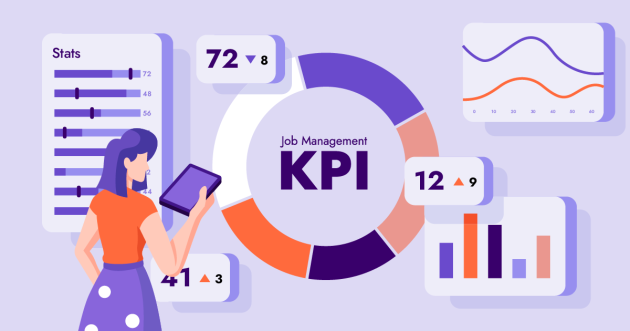Streamlining Field Service Management: The Power of Automation and Process Optimization

Imagine field service project managers no longer drowning in repetitive administrative tasks. Every day, these professionals juggle scheduling, data entry, and report generation—activities that sap time and energy from their primary mission: driving project success. The overwhelming load of manual tasks leads to inefficiencies, increased costs, and inevitable burnout.
Automation and process optimization can revolutionize field service operations. By harnessing the power of field service management software, businesses can drastically reduce the time and effort spent on administrative duties. This transformation enhances productivity and sharpens focus on strategic goals. In this blog, we will explore the challenges in field service management, understand their impact, and uncover how automation and process optimization can transform your operations. We’ll dive into the benefits and outline practical steps for seamless implementation.
Overburdened Project Managers – The Daily Grind of Administrative Tasks
Project managers in field service management are trapped in a relentless cycle of administrative duties that drain their energy and time. These include:
Scheduling: A Never-Ending Jigsaw Puzzle
Coordinating team schedules, client appointments, and resource allocation requires meticulous attention to detail to ensure no conflicts arise. This task is incredibly time-consuming and mentally exhausting, often leaving managers feeling overwhelmed and frustrated.
Data Entry: The Monotonous Chore
Manually inputting data from various sources into centralized systems is repetitive, tedious, and prone to human error, yet crucial for maintaining accurate records. The constant repetition can lead to significant mental fatigue, causing even the most diligent managers to slip up.
Report Generation: The Time Suck
Compiling and analyzing data to create reports for stakeholders requires significant time to ensure the data is correct and presented meaningfully. This process can consume hours that could be better spent on strategic tasks. The pressure to produce flawless reports adds to the stress and leaves managers with little time to focus on the big picture.
Impact on Core Responsibilities
These tasks, though crucial, are highly repetitive and time-consuming. They pull focus away from more critical activities like leading teams, resolving project issues, and strategic planning. The administrative load can hinder a project manager’s ability to stay engaged with their team’s needs and the project’s overarching goals.
Burnout and Lost Focus – The Toll of Repetitive Tasks
The burden of these routine tasks is significant:
Burnout: The Silent Productivity Killer
The repetitive nature of administrative duties can lead to mental fatigue and burnout. When project managers spend too much time on these tasks, their job satisfaction plummets, impacting their performance and morale. Burnout can also lead to increased turnover, which is costly for any organization. The constant cycle of hiring and training new managers disrupts business operations and drains resources.
Lost Focus: The Strategic Blind Spot
Time spent on administrative work is time not spent on the project’s big picture. This can slow down progress and lead to missed opportunities and overlooked details. Managers may struggle to maintain a strategic view when bogged down by minutiae. This lost focus can derail entire business initiatives, leading to costly delays and subpar project outcomes.
Increased Risk of Errors: The Hidden Costs
Manual processes are inherently prone to mistakes. Errors in scheduling, data entry, or reporting can cause delays, miscommunications, and cost overruns. These mistakes can erode client trust and damage the company’s reputation. The hidden costs of these errors can be devastating, affecting not just individual projects but the entire business.
Automation and Process Optimization – Embracing Technology
The key to alleviating the burden of administrative tasks in field service management lies in adopting advanced technology and refining existing processes. This approach not only streamlines operations but also significantly improves efficiency and accuracy.
Automation Tools: The Game Changers
Implementing field service management software that automates scheduling, data management, and report generation can save countless hours each week. These tools efficiently handle routine tasks, reducing the risk of errors and freeing up managers to focus on high-priority work. Here are some examples:
- Automated Scheduling Software: Helps efficiently coordinate team schedules, client appointments, and resource allocation. It ensures that managers can track time accurately and avoid conflicts.
- CRM Systems: Customer Relationship Management systems streamline data entry and management, ensuring that all customer information is accurate and easily accessible.
- Advanced Data Analytics Platforms: These platforms automate the report generation process, providing real-time insights and analytics without manual intervention.
By integrating these tools, businesses can manage their field service operations more effectively, allowing project managers to concentrate on strategic planning and decision-making.
Process Optimization: Streamlining Workflows
Optimizing processes involves a thorough analysis of current workflows to identify areas for improvement. This might mean eliminating unnecessary steps, consolidating tasks, or adopting new methodologies that enhance efficiency. Here are some strategies:
- Eliminate Redundant Steps: Review your workflows to find and remove steps that do not add value, thereby speeding up processes and reducing waste.
- Consolidate Tasks: Combine similar tasks to improve efficiency and reduce the time spent switching between different jobs.
- Adopt New Methodologies: Lean management techniques and Six Sigma methodologies can be particularly useful. These approaches focus on minimizing waste and maximizing value, ensuring that every step in the process adds value to the customer and the business.
By embracing these techniques, businesses can streamline their operations, making it easier to manage jobs, improve customer satisfaction, and boost overall productivity.
Evaluating Current Processes
To truly benefit from automation and process optimization, it’s essential to conduct a thorough review of your existing business processes. This evaluation will help identify bottlenecks, redundant steps, and tasks that can be automated, ultimately improving operational efficiency.
Conduct a Comprehensive Workflow Review
Start by mapping out your current workflows in detail. This visual representation will help you see the entire process from start to finish, making it easier to pinpoint areas where improvements can be made.
- Identify Bottlenecks: Look for stages in the workflow where tasks get delayed or resources are underutilized. Bottlenecks can significantly slow down your field service team and impact overall productivity.
- Spot Redundant Steps: Identify any steps that are repetitive or unnecessary. These can often be streamlined or eliminated to enhance efficiency.
- Highlight Automatable Tasks: Determine which tasks can be automated using field service management software. Automating routine tasks can free up your field service team to focus on more strategic activities.
Use Process Mapping for Clarity
Process mapping is a powerful tool that helps visualize workflows. By creating detailed maps, you can see the flow of tasks and information, making it easier to identify inefficiencies and areas for improvement. This clarity is crucial for implementing effective changes that enhance operational efficiency.
Engage Your Field Service Team
Involve your field service team in the evaluation process. They are the ones who interact with the workflows daily and can provide valuable insights into pain points and inefficiencies.
- Gather Insights: Hold meetings or workshops with your team to discuss current processes and gather their feedback. Understanding their perspectives can help you identify issues that might not be apparent from a managerial standpoint.
- Understand Pain Points: Ask team members about the challenges they face in their daily tasks. Their input can highlight specific areas where automation or process changes can make a significant impact.
Monitor Key Performance Indicators (KPIs)
To measure the effectiveness of your current processes and the impact of any changes, track key performance indicators (KPIs). KPIs such as job completion time, customer satisfaction, and resource utilization can provide a clear picture of your field service operations’ efficiency and effectiveness.
By thoroughly evaluating your current business processes, engaging with your field service team, and using process mapping and KPIs, you can identify and implement changes that will significantly improve efficiency in your field service management.
Choosing the Right Tools
Investing in the right field service management software is crucial for streamlining processes and optimizing operations. The right tools enhance productivity, save time, and improve efficiency. Here’s how to choose the best tools:
Comprehensive Capabilities
Select software with features that address various aspects of your operations, such as:
- Automation: Automate scheduling, data management, and report generation to reduce manual workload and minimize errors.
- Scheduling: Efficiently coordinate team schedules, client appointments, and resource allocation, minimizing conflicts and managing time effectively.
- Real-Time Data: Ensure all team members have access to the most current information for informed decision-making.
Integration and Usability
Choose solutions that integrate seamlessly with your existing systems to ensure smooth transitions and uninterrupted workflows. Additionally, consider:
- User-Friendly Interface: Ensure the software is intuitive, requiring minimal training.
- Mobile Accessibility: Enable your team to stay connected and manage tasks on the go with mobile capabilities, enhancing communication and real-time updates.
Business Needs
Assess the software based on your specific needs, considering:
- Scalability: The software should grow with your business, accommodating more users and expanding operations.
- Tailored Features: Look for features customized to your industry and specific business processes, ensuring the software meets your unique requirements.
Enhancing Customer Experience
The right tools can significantly improve the customer experience by ensuring timely and accurate service delivery. Features to consider include:
- Communication Tools: Facilitate seamless communication between your team and customers. Automated notifications and updates keep customers informed and engaged.
- Customer Experience: Tools that provide accurate, timely information and efficient service delivery lead to higher satisfaction and loyalty.
Boosting Team Productivity
Implement software with comprehensive automation capabilities to boost your team’s productivity. Automation reduces time spent on repetitive tasks, allowing your team to focus on more strategic activities, which saves time and enhances job satisfaction and efficiency.
Selecting the right tools is a vital step in transforming field service management.
Training Your Team
Properly training your team in using new field service management software is essential for optimizing processes and ensuring business success. Without adequate training, even the most advanced tools can fail to deliver their full potential. Here’s why training your field service teams is crucial and how it can significantly benefit your operations.
The Importance of Training for Field Technicians
Field technicians are the frontline workers who interact with the field service management software daily. Ensuring they are well-versed in using new tools is vital for several reasons:
- Efficiency and Productivity: Quick, efficient navigation of the software. More time for core responsibilities. Boosts productivity.
- Accuracy and Reliability: Minimizes errors in data entry, scheduling, reporting. Crucial for informed decisions, reliable records.
- Enhanced Customer Service: Better service to customers. Quick information access, accurate responses, effective issue resolution. Higher customer satisfaction.
Comprehensive Training Sessions
Offer comprehensive training sessions tailored to your field service teams. These sessions should cover:
- Software Navigation: Efficient use of key features and tools.
- Process Integration: Simplifying and optimizing daily tasks.
- Troubleshooting and Support: Resolving common issues confidently.
Ongoing Support and Continuous Learning
Training should be continuous. Ongoing support is crucial for maintaining proficiency and adapting to updates or changes in the software:
- Regular Updates: Keep teams informed about updates and new features. Regular refresher courses.
- Support Resources: Access to user manuals, online tutorials, helpdesk. Quick issue resolution.
- Encourage Improvement: Culture of continuous improvement. Feedback and enhancements for better software utilization.
Impact on Business Success
Proper training of your field service teams in the use of field service management software directly impacts business success:
- Operational Efficiency: Streamlined operations. Reduced time on manual tasks. Improved workflow.
- Cost Savings: Minimized errors, improved productivity. Significant cost savings. Better resource utilization.
- Competitive Advantage: Superior service with advanced tools. Competitive edge. Enhanced customer satisfaction and loyalty. Drives growth and profitability.
By investing in comprehensive training for your field technicians and field service teams, you ensure your new field service management software delivers its full potential, optimizing processes and contributing to your business’s long-term success.
Monitoring and Adjusting
Continuously monitor the impact of automation and process changes. Gather team feedback and adjust as needed. Use performance metrics to track improvements and refine processes regularly to align with business goals and best practices.
Enhanced Productivity and Project Success
Time Savings with Automation
Implementing field service management software automates routine tasks, resulting in significant time savings:
- Faster Task Completion: Automated scheduling, data management, and report generation are quicker than manual processes, freeing up hours for strategic planning and problem-solving.
- Efficiency Boost: Automation minimizes repetitive tasks, allowing teams to focus on high-priority activities, leading to faster project turnaround and the ability to handle more projects.
- Integrated Solution: Field service software streamlines various operations, reducing the need to switch between different tools and systems.
Improved Accuracy through Automation
Automation enhances accuracy, leading to better outcomes:
- Reduction of Human Error: Automated systems ensure precise data entry, scheduling, and reporting, keeping your data accurate and up-to-date.
- Reliable Decision-Making: Accurate data supports informed decisions, improving project success and business growth.
- Enhanced Reporting: Automation provides dependable insights into performance, building trust and enabling effective tracking of key metrics.
Streamlining Business Operations
Automation optimizes and streamlines business operations:
- Optimized Workflow: Ensures tasks are completed consistently and timely, leading to smoother operations and better team coordination.
- Seamless Integration: Combines various operational aspects into one cohesive system, simplifying management and enhancing efficiency.
- Real-Time Data: Field service software offers real-time data synchronization and mobile access, keeping your team updated and further optimizing efficiency.
By implementing field service management software and leveraging its automation capabilities, your business can achieve significant time savings, improved accuracy, optimized operations, and overall success.
Field Service Management Software: A Closer Look
Choosing the right field service management software is crucial for optimizing operations and ensuring seamless workflow. Here are the key features to consider:
Key Features of Effective Software
Automated Scheduling
- Handle Complex Variables: Manage dependencies like technician availability, skill sets, and client preferences.
- Ensure Optimal Resource Allocation: Assign the right technician based on real-time data, maximizing efficiency and reducing downtime.
- Minimize Scheduling Conflicts: Reduce double-bookings or missed appointments, enhancing customer satisfaction.
Data Management
- Integrate with Other Systems: Connect with CRM, ERP, and other critical systems for a unified view of operations.
- Enhance Data Accuracy: Automated data entry reduces human errors, ensuring reliable records.
- Simplify Data Access: Easy access to necessary information from a single platform, improving decision-making.
Reporting Tools
- Customizable Templates: Create reports that meet specific needs.
- Real-Time Data Updates: Ensure reports are based on the latest data for accurate insights.
- Facilitate Easy Sharing: Quick and simple sharing with stakeholders, improving transparency.
Integration Capabilities
- APIs and Integration Tools: Connect with existing systems for harmonious operation.
- Data Synchronization: Real-time synchronization enhances coordination and efficiency.
- Minimal Disruption: Seamless integration allows smooth transitions and continued effective work.
User-Friendly Interface
- Intuitive: Easy navigation with a logical layout and clear instructions.
- Feature-Rich: Drag-and-drop scheduling, real-time notifications, and mobile access enhance usability.
- Mobile Accessibility: On-the-go access for field technicians and managers ensures they have the information they need when they need it.
The Role of Automation in Field Service Management Solutions
Automation is a game-changer for field service management, addressing numerous pain points and significantly enhancing overall efficiency. Here’s why you should consider integrating automation into your field service operations:
Reducing Manual Work
One of the most compelling reasons to adopt automation is its ability to drastically reduce manual work. Field service management software can automate a range of routine tasks, freeing up valuable time for your project managers and field technicians.
- Automated Workflows: Tasks such as dispatching, invoicing, and inventory management can be automated, reducing the need for manual intervention. This allows your team to focus on more strategic activities that drive business growth.
- Eliminating Double Data Entry: Automated data management ensures that information is entered once and used across multiple systems, eliminating the need for repetitive data entry and reducing the risk of errors.
Minimizing Errors
Automation significantly reduces the likelihood of human error, which can have costly repercussions in field service management.
- Precision and Consistency: Automated systems handle tasks with a high degree of accuracy, ensuring that data is consistently reliable. This reduces the risk of mistakes in scheduling, invoicing, and reporting.
- Error Reduction: By automating data entry and other repetitive tasks, the chances of errors are minimized, leading to more accurate records and smoother operations.
Saving Time
Time savings are a major benefit of automation, allowing your team to accomplish more in less time.
- Streamlined Processes: Automation accelerates routine tasks, ensuring they are completed quickly and efficiently. This frees up hours each week that can be redirected towards strategic planning and problem-solving.
- Faster Turnaround: With tasks being handled automatically, projects can be completed more rapidly, improving overall turnaround times and enabling your business to take on more projects.
Improving Resource Allocation
Effective resource allocation is crucial for maximizing productivity and ensuring that projects are completed on time.
- Real-Time Data and Insights: Automation provides real-time data and insights, helping you allocate resources more effectively. Tools like AI-powered scheduling can predict and address resource conflicts, ensuring that your team is always optimally deployed.
- Maximizing Efficiency: By ensuring that the right resources are assigned to the right tasks, automation helps to minimize downtime and maximize productivity.
Enhancing Communication
Clear and timely communication is essential for the success of any field service operation.
- Automated Notifications: Automation tools can send timely updates and reminders to team members, clients, and stakeholders, ensuring everyone is kept in the loop. This reduces the risk of miscommunication and enhances coordination.
- Seamless Coordination: Automated communication tools ensure seamless coordination among all parties involved, facilitating better teamwork and more efficient project execution.
Boosting Overall Efficiency
Automation enhances the overall efficiency of field service management by streamlining workflows and improving operational processes.
- Optimized Workflows: By automating routine tasks, you can create more streamlined workflows that reduce bottlenecks and improve overall efficiency.
- Enhanced Productivity: With less time spent on manual tasks and fewer errors to correct, your team can focus on higher-value activities, boosting overall productivity and contributing to business growth.
By integrating automation into your field service management operations, you can achieve significant improvements in reducing manual work, minimizing errors, saving time, improving resource allocation, enhancing communication, and boosting overall efficiency.
Process Optimization: Streamlining Workflows
Identifying Bottlenecks
Analyze current workflows to identify bottlenecks that slow down processes and impact productivity and customer satisfaction. Use tools like value stream mapping to visualize and address these bottlenecks, enabling targeted improvements that enhance efficiency and reduce frustration for team members and clients.
Eliminating Redundant Steps
Streamline workflows by eliminating redundant steps. Consolidate tasks, simplify approval processes, and reduce unnecessary documentation to speed up operations. This reduces waste, lowers costs, and shortens project timelines, allowing your team to focus on critical tasks and become more agile and responsive.
Adopting New Methodologies
Adopt methodologies that promote flexibility and responsiveness, such as Agile project management and Lean principles. These approaches eliminate waste, improve value delivery, and foster a culture of continuous improvement and innovation, helping your team stay competitive in a rapidly changing market.
Benefits Beyond Time Savings
Automation and process optimization provide benefits beyond time savings, including improved efficiency, reduced costs, enhanced customer satisfaction, and overall business growth.
Increased Project Success Rates
Automation and process optimization ensure that tasks are completed accurately and efficiently, which directly contributes to higher project success rates. When tasks are handled with precision, the likelihood of errors is minimized, and processes flow more smoothly. This efficiency leads to timely project completion, crucial for meeting client expectations and maintaining project timelines.
- Enhanced reputation and client trust: More projects completed on time and within budget.
- Stable revenue stream and financial health: Consistently successful projects lead to this.
Better Client Satisfaction
Improved accuracy and timely project completion lead to higher client satisfaction. When clients receive reliable and prompt service, their trust in your company increases. Happy clients are more likely to return for future services and refer your business to others, creating a positive feedback loop.
- Repeat business is cost-effective: High client satisfaction leads to this.
- Invaluable word-of-mouth referrals: Positive client feedback drives this growth.
- Differentiation from competitors: Enhanced client satisfaction achieves this.
Competitive Advantage
Leveraging technology and optimized processes gives your business a competitive edge in the field service industry. Staying ahead of the competition requires adopting the latest tools and techniques to continuously improve your operations. Automation and process optimization not only enhance efficiency but also enable your business to adapt quickly to changes and new demands.
- Stand out in a crowded market: Competitive advantage helps with this.
- Attract more clients and secure projects: Efficiency and innovation lead to this.
- Ensure long-term success and sustainability: Continuous improvement and innovation achieve this.
Enhanced Operational Efficiency
Beyond individual projects, the overall operational efficiency of your business improves with automation and process optimization. Streamlined workflows, reduced manual intervention, and better resource allocation all contribute to smoother operations.
- Do more with the same resources: Enhanced operational efficiency allows this.
- Cost savings and higher profit margins: Efficiency leads to these benefits.
- Reduce employee burnout and improve job satisfaction: Efficient operations achieve this.
Data-Driven Decision Making
Automation tools often come with advanced analytics and reporting capabilities, providing valuable insights into your operations. Access to accurate, real-time data allows for better decision-making and strategic planning.
- Identify trends, anticipate challenges, and seize opportunities: Data-driven decision-making helps with this.
- Optimize resource allocation, improve service delivery, and drive continuous improvement: Accurate data supports these efforts.
- Build trust and confidence with stakeholders: Transparent communication achieved through reliable data.
By embracing the benefits beyond time savings—such as increased project success rates, better client satisfaction, competitive advantage, enhanced operational efficiency, and data-driven decision-making—your business can achieve sustained growth and success. These benefits are crucial for establishing a strong market position and ensuring long-term profitability and client loyalty.
In the field service industry, where efficiency and accuracy are crucial, embracing automation and process optimization is a game-changer. By leveraging technology, project managers can slash administrative overhead, focus on critical goals, and drive success. Automation handles repetitive tasks, freeing up time for strategic activities, while refined processes boost efficiency and accuracy, leading to better project outcomes. FieldInsight provides robust automation tools to streamline operations, eliminate inefficiencies, reduce errors, and enhance reliability. Choose FieldInsight to stay ahead with cutting-edge technology and continuous innovation, making your field service management more effective and productive.
What You Should Do Now
- Book a Demo. You’ll be in touch with an automation expert who has worked in this space for over 5 years, and knows the optimal workflow to address your needs.
- If you’d like access to free articles about managing HVAC workflows, go to our blog.
- If you know someone who’d enjoy reading this page, share it with them via email, Linkedin, Twitter, or Facebook.










